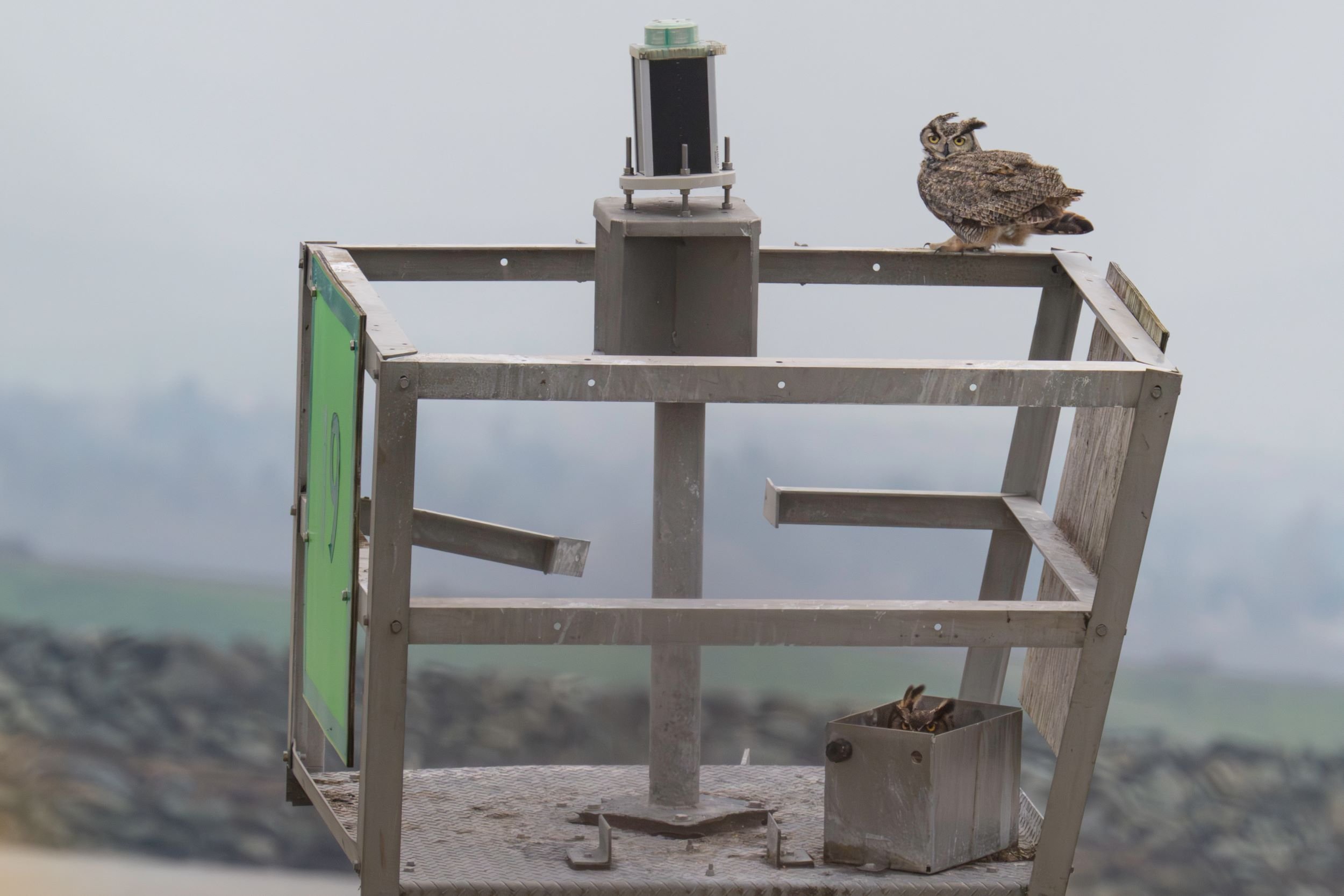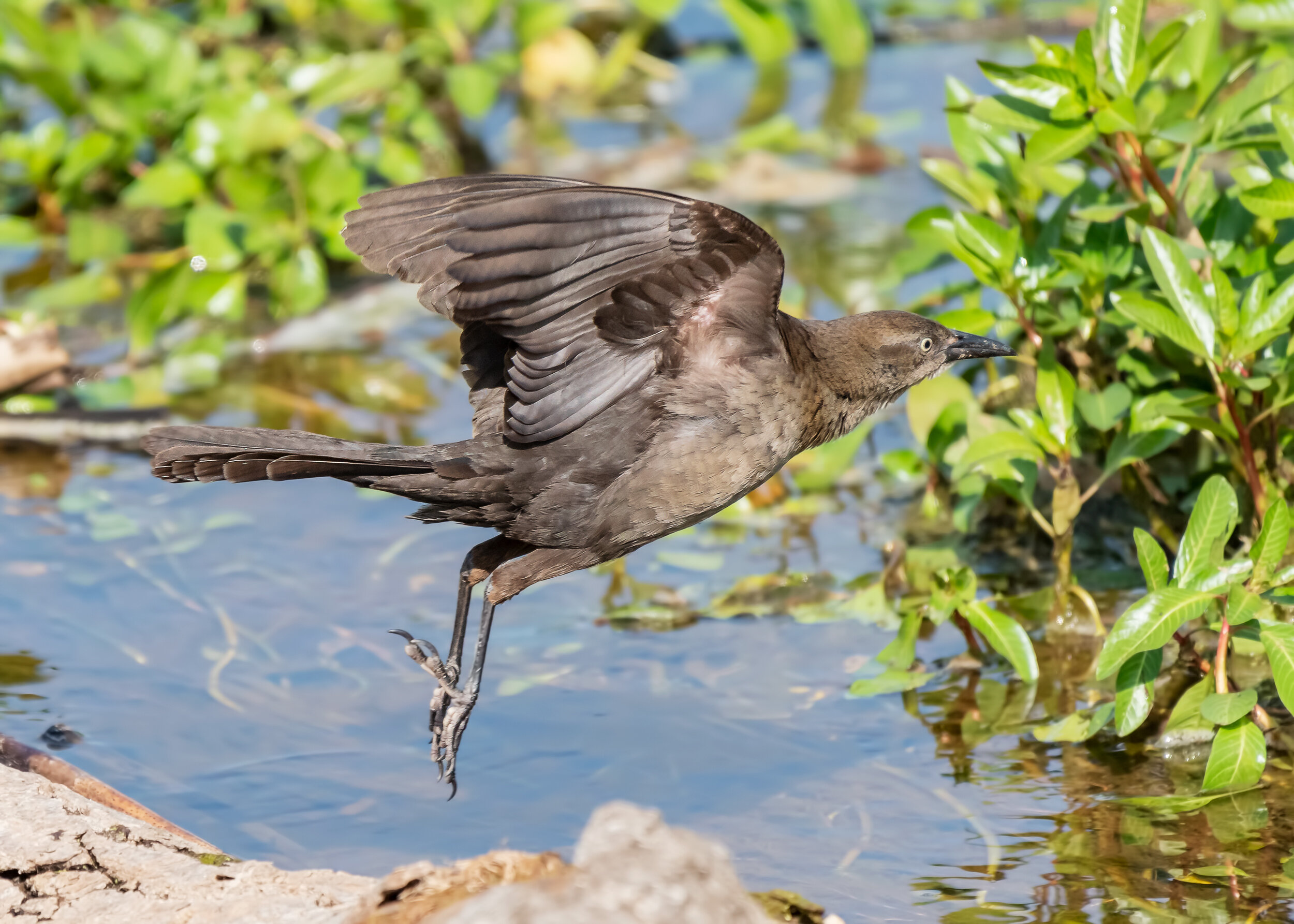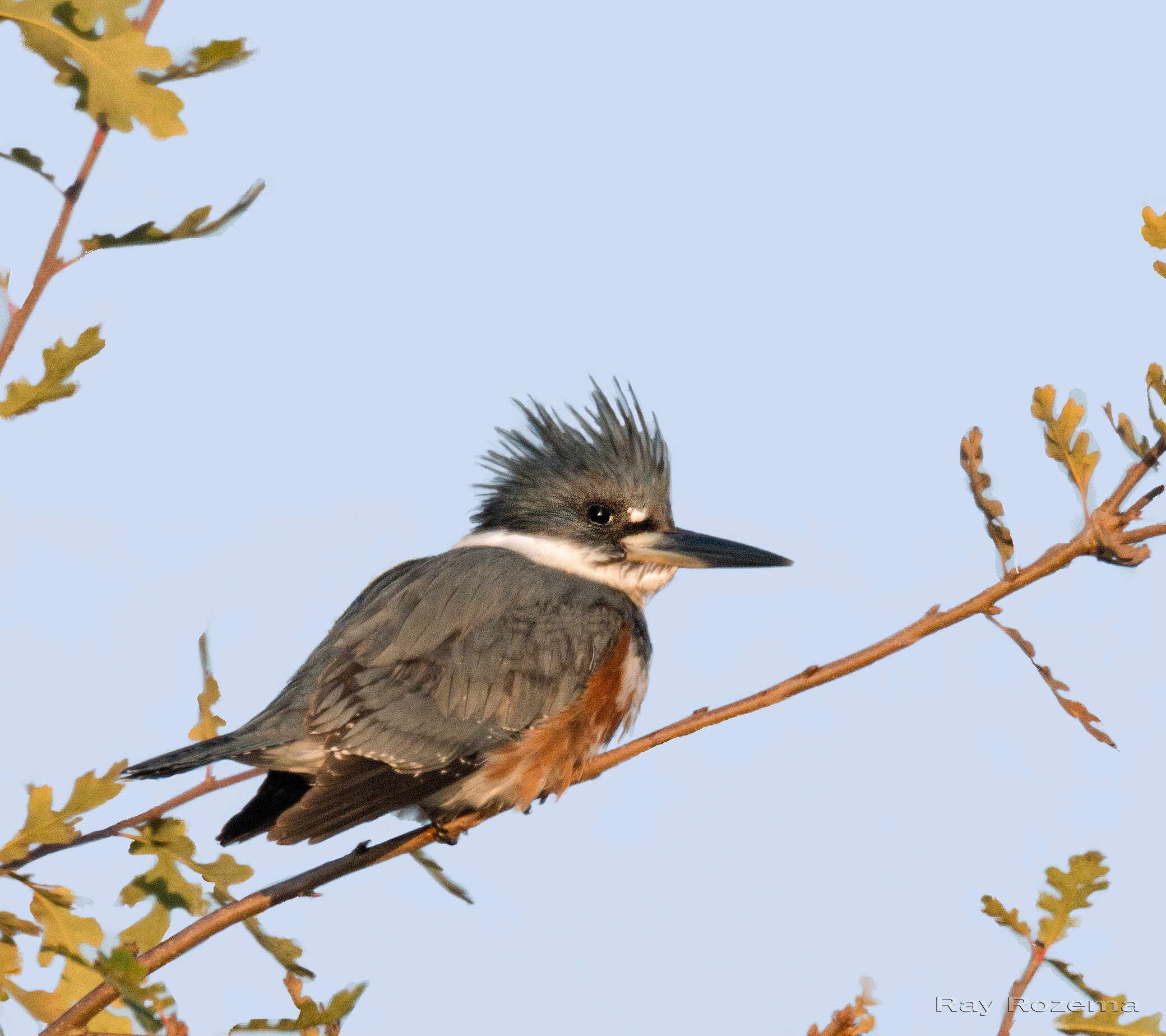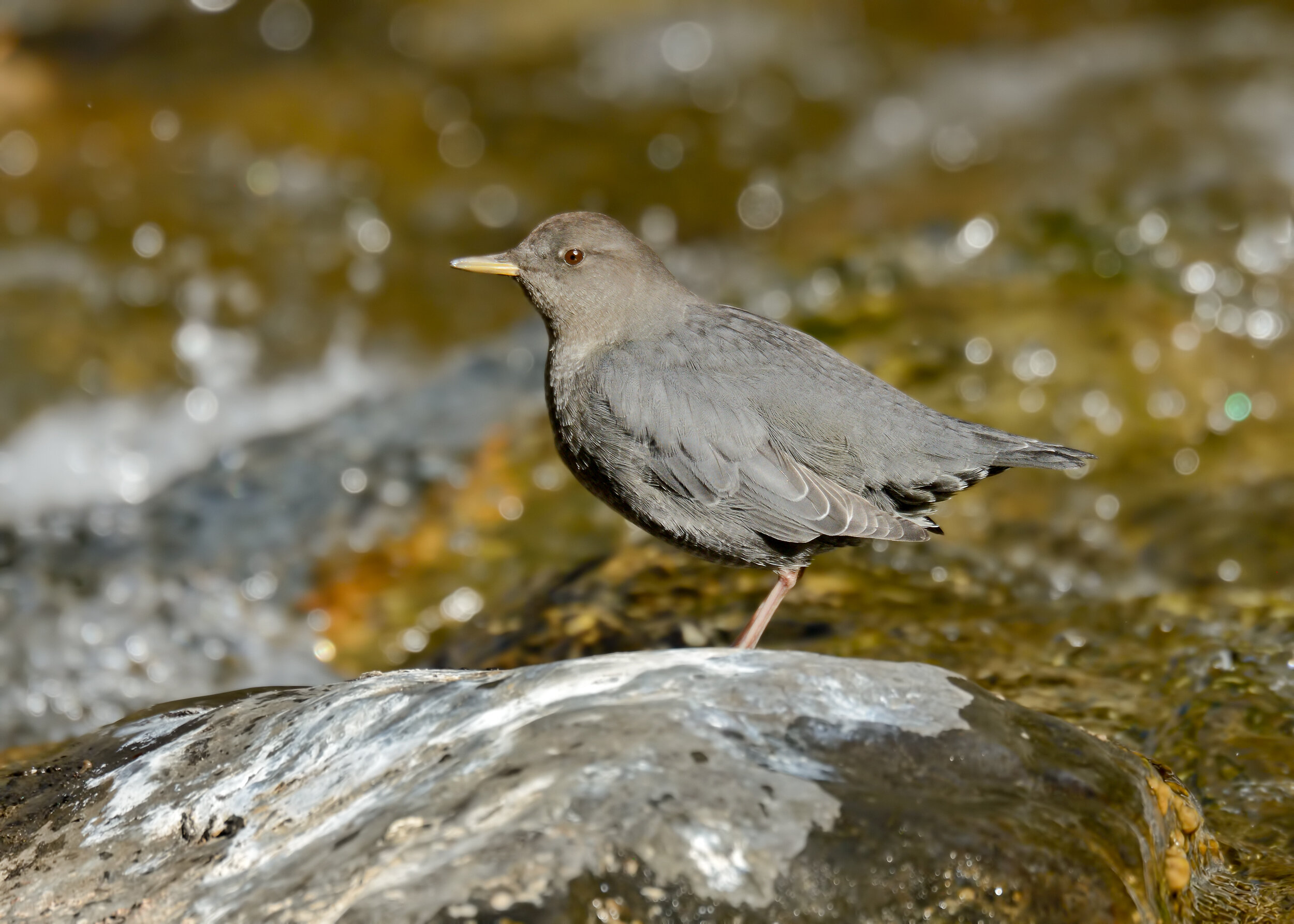Sacramento River Delta Cruise, 2/17
Leader Sonja Sorbo reported: Mother Nature nearly derailed this trip with an “atmospheric river” — we nervously watched the weather forecast in the days leading up to the trip. Fortunately, the storm held off until the afternoon, so we boldly showed up at Antioch Marina and our charter boat launched. 23 birders had a great day; despite overcast skies, there was only light wind and occasional light rain. We were able to enjoy views of thousands of birds, (62 species total) including a couple of unexpected sightings. After departing the marina, our first raptor was a Bald Eagle on the nest. The next several miles produced multiple Red-tailed Hawks, a pair of Northern Harriers, and a White-tailed Kite, the latter gracefully hovering above a field. The most memorable raptor sighting of the day was a pair of Great Horned Owls hunkered down on a marker platform in the middle of the channel! Perhaps the cage-like structure on top of the marker seemed enough like a nest to make them happy….later in the day we saw yet another Great Horned Owl perched on a channel marker, giving the photographers a field day.
Image by Ken Stites
The most memorable raptor sighting of the day was a pair of Great Horned Owls hunkered down on a marker platform in the middle of the channel!
Image by Ken Stites
Cruising down the channels, we noted several large groups of scaup and an occasional Bufflehead and Common Goldeneye. Ducks in general were scarce, in keeping with results from recent Christmas Bird Counts. We did manage to see a few Mallards and Shovelers.It seemed as though we couldn’t travel more than a few hundred yards without a Double-crested Cormorant crossing our path — they were everywhere (as were American Coots). Many pilings, utility towers, and channel markers were occupied by cormorants. There were also several huge trees supporting “cormorant condominiums” with the birds coming and going to and from a multitude of nests.
As we proceeded around the various islands, we discovered multiple fields with huge gatherings of Snow Geese, increasing by the moment as geese flying in skeins in the sky above dropped down to join the crowd. Our total for the day was well over 15,000. Greater White-fronted Geese were also present, but in much smaller numbers. To our delight, we noted a couple of hundred Sandhill Cranes sandwiched into some of the fields, looking as regal as ever. One pair of fields was particularly attractive to Tundra Swans, supporting approximately two hundred of the magnificent creatures.
Snow Geese, Image by Ken Stites
Although our attention was focused on waterfowl, we also tallied other species including California, Western, and Herring Gull, Forster’s Tern, Western and Pied-billed Grebe, American White Pelican, Belted Kingfisher, Tree Swallow, Anna’s Hummingbird, Black Phoebe, Song Sparrow, American Bittern, Green Heron, juvenile Black-crowned Night Heron, Great Egret, and Great Blue Heron.
Great Egret, Image by Ken Stites
Heard were Wrentit and Marsh Wren. Several times, the boat moved close to the levee and flushed scores of Western Meadowlarks. Their gorgeous song was frequent enough to almost provide a soundtrack for the cruise. While heading back to the marina, we passed a field with a spectacular murmuration of blackbirds in progress. It was mesmerizing! At the end of the cruise, our boat turned into the marina entrance and behold! A Red-throated Loon paddled around, unfazed by a boatful of birders passing just a few yards away who were snapping photos right and left….it was a delightful surprise and lifer for many in the group. A quick walk around the marina by some of the birders produced views of White-and Golden-crowned Sparrows, Fox Sparrow, Spotted Towhee, Northern Mockingbird, Great-tailed Grackle, Yellow-rumped Warbler, and Bushtit. After that, it was a fast dash to the vehicles to head for home before the “atmospheric river” arrived……..
Sacramento WLR, 2/18
Leader Cliff Feldheim reported: Presumably because of the weather, we had a low turnout for our trip. With all the rain we have been getting I was concerned that we would not see the abundance of waterfowl one would expect this time of year, as they would be spread out using newly flooded areas. Duck numbers were lower than expected and of the 11 species we saw Northern Shoveler, Northern Pintail, and Gadwall were the most abundant. Although we did get very good looks at Blue-winged Teal on the pond nearest the viewing platform. White-fronted, Snow, and Ross's Geese numbers were similarly low with not more than 150 of each species seen. Given the low numbers of waterfowl, we were pleasantly surprised to see 3 different adult Bald Eagles, 2 of which gave us great looks, as well as one Peregrine Falcon. Leaving the Refuge we drove through some of the rice fields south and east of the Refuge and did see some fields with excess of 3,000 Snow/Ross's Geese in them. Despite the relatively slow day of birding we managed 46 species of birds and enjoyed the break from the rain.
Bald Eagles were seen on both the Sacramento WLR and Gray Lodge WLR field trips. Image by Paul Miller
Gray Lodge WLR, 2/24
Leader Paul Miller reported: Four participants joined me for an accessible birding trip at Gray Lodge Wildlife Area. There is a wonderful paved trail starting at Lot #14 and leading to a raised overlook. While the Snow Geese numbers were lower than previous weeks there were many waterfowl to observe. Highlights of the trip included a mature Bald Eagle, Ruddy Ducks, American Avocet, Common Goldeneye, and Buffleheads.
Ancil Hoffman Park, 2/25
Co-leaders Rich Howard and Dana Miller-Blair reported: We arrived at 7:30 am to meet 21 participants (a mix of experienced and new birdwatchers) and gratefully accepted assistance from Betty Cooper, Cathie LaZier and Jane Van Kessel. The morning was sunny, with a few thin clouds, and windless with temperatures in the 50s-60s, making for very pleasant birding. Nest building is commencing – we watched Yellow-billed Magpies adding to their nests, Bushtits flying in and out of their sock-like nest and a House Wren exploring holes for nesting. Male and female Wood Ducks were in the trees looking for nest holes. Highlights of the trip were four Chipping Sparrows, a Phainopepla, a good variety of woodpeckers including Downy, Nuttall’s, Acorn, and Northern Flickers. We had great looks at Red-shouldered Hawks. A flock of California Quail was out in the open for all to see. Tree Swallows are returning to the valley - we saw 4. The river was quite high, so water birds were scarce, but we did get 1 Killdeer, and some ducks that will migrate away soon - 3 Buffleheads and 1 Common Goldeneye, along with Mallards and Common Mergansers. The work which had been done to create salmon nesting habitat resulted in what was formerly a peninsula now becoming an island, which is not accessible to us now. We had a flyby of Greater White-fronted Geese. Yellow-rumped Warblers were abundant, and we saw many White-crowned and Golden-crowned Sparrows, as well as Dark-eyed Juncos. Along with the expected American Crows, we saw one Common Raven. We had a total of 47 species for the trip, but after the trip ended, and most participants had left, 4 of us watched and heard 2 large flocks of Sandhill Cranes, as well as White-throated Swifts and more Tree Swallows. The Bird list is available here: https://ebird.org/checklist/S162928417.
Bushtit with Nest, Image by Larry Hickey
Mather Lake, 2/28
Susan Goodrich, co-leader with Jane Van Kessel, reported: 12 enthusiastic birders spent a clear cool and sunny morning exploring Mather Lake, starting with a plethora of parking lot peeps, including Great-tailed Grackles, Brown-headed Cowbirds, and Brewer's Blackbirds. The Green Heron eluded us on our first pass of the riprap, but a sharp eye spied it the second time around, and everyone got a view of its dark green back and chestnut neck shining in the sun. Lots of terrific spotters helped spy a variety of our local winter residents, including Western Bluebirds, Western Meadowlark, Northern Flickers, a variety of finches and sparrows, and, not one, but two Red-breasted Sapsuckers! Spring was in the air as we watched pairs of Bushtits, Tree Swallows, White-tailed Kites, and even Red-tailed Hawks proclaiming their territories and pairing up. We were able to get scope views of the White-tailed Kites constructing a nest. The lake yielded a number of Pied-billed Grebes, Double-crested Cormorants, a couple of Common Gallinules, and a surprise showing of a group of Northern Shovelers! A bittersweet delight was heard in the overhead call of Sandhill Cranes gathering and flying north to their summer breeding grounds. The very pleasant morning with a great group of folks concluded with a surprise visit and eventual counting of five otters playing in the lake! eBird list here: https://ebird.org/checklist/S163204128
Female Great-tailed Grackle, Image by Daniel Lee Brown
Coyote and University Ponds, 3/2
Nancy Gronert, co-leader with Amy Mcdonald, reported: The storms held off for the Saturday morning trip to Coyote Pond Park off Highway 65. Five birders braved the chilly temperatures to be greeted by flocks of Lark Sparrows with their vivid faces. The group strolled along the ponds to find a nice selection of waterbirds: Common Gallinule, Pied-billed Grebes, American Wigeon, American Coots, a Great Blue Heron, Great Egrets with Tree Swallows and Rough-winged Swallows skimming Whistler Pond. Northern Flickers, Acorn, Downy and Nuttall’s Woodpeckers checked out the trees along with flocks of Western Bluebirds and Yellow-rumped Warblers. Along with a Great-tailed Grackle, pairs of Red-tailed Hawks, Red-shouldered Hawks, and American Kestrel showed along our walk. The group spied a Merlin dangling some sparrow - hopefully House - towards the end of the walk. The usual winter suspects of Ruby-crowned Kinglets, crowned Sparrows, White-breasted Nuthatches, a Hermit Thrush, and American Robins were visible as well.
“Five birders braved the chilly temperatures to be greeted by flocks of Lark Sparrows with their vivid faces.” Image by Mary Forrestal
Bobelaine, 3/3
Leader Maureen Geiger reported that the trip was cancelled because of flooded trails.
Lake Solano, 3/6
Leader Bill Bianco reported: Four of us started the day with cool and overcast skies. We ended our walk with a total species count of 47. Over our 3.75 hour leisurely walk we had good sightings of Belted Kingfisher, Osprey, Hermit Thrush, Phainopepla, Orange-crowned Warbler, breeding behavior of Red-shouldered Hawks, Red-breasted Sapsucker, Wood Ducks, Hooded and Common Mergansers, naming a few. At lunch break the sun came out and we saw the only hummingbird after our walk. Very enjoyable morning for all.
Belted Kingfisher, Image by Ray Rozema
Hidden Falls Regional Park, 3/7
Leader Peter Perrine reported: Eight of us enjoyed a beautiful spring day at Hidden Falls Regional Park, and for six of us, it was the first time there. We saw and heard the expected species, such as Acorn Woodpeckers, White-breasted Nuthatches, Western Bluebirds (which we nearly missed), Black Phoebes and Spotted Towhees. Ruby-crowned Kinglets and Yellow-rumped Warblers were abundant, almost overwhelmingly so on occasion. Some nice finds were one calling Golden-crowned Kinglet, two Rufous-crowned Sparrows, a Northern Rough-winged Swallow (first this spring for all of us), and two Steller’s Jays (twice as many as California Scrub-Jays). Orange-crowned Warblers were singing throughout the morning, and we got good looks at one, which was a life bird for one person. The best bird of the day, though, was an American Dipper, well seen by all from the Coon Creek overlook. With 35 bird species seen, and spring flowers like Shooting Stars and Buttercups starting to show in the fresh new green grass, we had a most enjoyable outing.
“The best bird of the day, though, was an American Dipper.” Image by Daniel Lee Brown.
Woodland Wastewater Treatment Plant, 3/10
Leader Mark Martucci reported: Seventeen people detected 62 species of birds on a very comfortable overcast morning in Yolo County. Highlights included Canvasback, Redhead, Lesser Scaup, Western Grebe, Clark's Grebe, Long-billed Curlew, Barn Owl, Bonaparte's Gull, Loggerhead Shrike, and Yellow-headed Blackbird.
A Barn Owl was one of the sixty-two species on the Woodland Wastewater Treatment Plant field trip. Image by Daniel Lee Brown.











